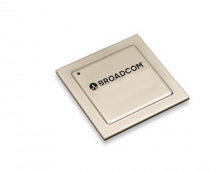
MWC2014: Broadcom Packs 5G WiFi 2x2 MIMO into Smartphones
At Mobile World Congress this week, Broadcom unveiled the BCM4354, the first 5G WiFi, or 802.11ac 2x2 MIMO system-on-a-chip (SoC) for smartphones.
The SoC enables smartphones to find and keep a clearer and more powerful Wi-Fi signal, essentially doubling wireless performance and widening coverage areas, while increasing system power efficiency.
2x2 MIMO (pronounced My-Mo) "uses two antennas to transmit and receive two streams of data at the same time, so it effectively doubles throughput," explained Dino Bekis, vice president of product marketing, Mobile Wireless Connectivity Combos, at Broadcom.
Those antennas, which send out parallel signals, can also be configured to deliver the same throughput at a greater distance. That increases the chances of getting a signal in challenging, congested environments - like connecting from the basement to a router stuffed in an upstairs closet, or in a busy city environment jammed with interference from other people and objects.
Making do with single-antenna connection, which is found in most smartphones today, means that Wi-Fi reliability takes a hit. In some cases, that connection can be impacted by how and where people physically hold their devices.
MIMO, by contrast, uses multipath communication to increase the likelihood of a strong Wi-Fi signal, regardless of how the phone is held or the obstacles that might be in the way. Under the hood, multiple signals are converted into a single, clear channel.
And because it uses 5G WiFi, the BCM4354 has a beam-forming capability, which means that it dynamically senses the environment for transmitting Wi-Fi signals and steers the beams to a specific device. This is done through a "handshaking protocol" that allows the device and router to communicate about where to send the signal.
To engineer the BCM4354, Broadcom had to break through several technological challenges, from making sure that MIMO antennas didn?t adversely affect battery life to fitting the new chip into a footprint comparable to existing single antenna solutions.
It took a lot of proprietary enhancements to the radio design, Bekis says, to compensate for the less-than-ideal antenna conditions in a tightly packed smartphone environment. The result is a 2?2 MIMO SoC solution that works just as well as those on tablets and laptops.
Bringing 5G WiFi with 2x2 MIMO to smartphones will also make carriers and device makers happy, as they'll get more ability to offload network traffic from their 3G and LTE networks to Wi-Fi.
Carriers will also get more out of their managed Wi-Fi networks and hot-spots in big public spaces, such as sports arenas and concert venues, where the quality of the Wi-Fi network is sure to be noticed by thousands of people uploading and sharing content in real-time.
The BCM4354 supports Android, Windows and Chrome-based operating systems. There's even a version that supports Rezence wireless power technology, developed by the Alliance for Wireless Power (A4WP).
Bekis said he expects the first MIMO-equipped smartphones to be announced this quarter, with mainstream availability by summer.
2x2 MIMO (pronounced My-Mo) "uses two antennas to transmit and receive two streams of data at the same time, so it effectively doubles throughput," explained Dino Bekis, vice president of product marketing, Mobile Wireless Connectivity Combos, at Broadcom.
Those antennas, which send out parallel signals, can also be configured to deliver the same throughput at a greater distance. That increases the chances of getting a signal in challenging, congested environments - like connecting from the basement to a router stuffed in an upstairs closet, or in a busy city environment jammed with interference from other people and objects.
Making do with single-antenna connection, which is found in most smartphones today, means that Wi-Fi reliability takes a hit. In some cases, that connection can be impacted by how and where people physically hold their devices.
MIMO, by contrast, uses multipath communication to increase the likelihood of a strong Wi-Fi signal, regardless of how the phone is held or the obstacles that might be in the way. Under the hood, multiple signals are converted into a single, clear channel.
And because it uses 5G WiFi, the BCM4354 has a beam-forming capability, which means that it dynamically senses the environment for transmitting Wi-Fi signals and steers the beams to a specific device. This is done through a "handshaking protocol" that allows the device and router to communicate about where to send the signal.
To engineer the BCM4354, Broadcom had to break through several technological challenges, from making sure that MIMO antennas didn?t adversely affect battery life to fitting the new chip into a footprint comparable to existing single antenna solutions.
It took a lot of proprietary enhancements to the radio design, Bekis says, to compensate for the less-than-ideal antenna conditions in a tightly packed smartphone environment. The result is a 2?2 MIMO SoC solution that works just as well as those on tablets and laptops.
Bringing 5G WiFi with 2x2 MIMO to smartphones will also make carriers and device makers happy, as they'll get more ability to offload network traffic from their 3G and LTE networks to Wi-Fi.
Carriers will also get more out of their managed Wi-Fi networks and hot-spots in big public spaces, such as sports arenas and concert venues, where the quality of the Wi-Fi network is sure to be noticed by thousands of people uploading and sharing content in real-time.
The BCM4354 supports Android, Windows and Chrome-based operating systems. There's even a version that supports Rezence wireless power technology, developed by the Alliance for Wireless Power (A4WP).
Bekis said he expects the first MIMO-equipped smartphones to be announced this quarter, with mainstream availability by summer.




















